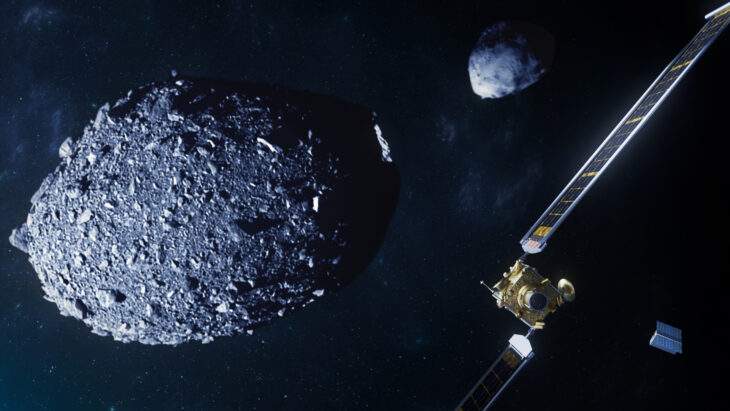On September 22, 2022, NASA did something no space program had ever done before – they smashed a spacecraft into an asteroid to alter its orbit. Scientists declared the mission, named the Double Asteroid Redirection Test, or DART, a resounding success. The main goal of DART was to test a method of planetary defense against hazardous asteroids on a collision-course for Earth. The researchers involved recently released a series of papers describing what happened when DART collided with its target.
The Center for Near Earth Object Studies (CNEOS) defines potentially hazardous asteroids as more than 150 meters (500 feet) in diameter, with orbits that intersect Earth to within about 20 times the distance from here to the moon. CNEOS scientists haven’t found any planet-threatening asteroids set to collide with Earth for at least the next 100 years. But they aren’t able to track objects as small as 30 meters (about 100 feet), which could still destroy entire regions of the globe if they hit us. Researchers are looking for ways to prevent potential impacts of all sizes.
Scientists have proposed the best way to stop an asteroid from colliding with Earth is to deflect it by ramming something into it at high speed to change its orbit, a process called kinetic impact. They also recognized the need to develop and test the appropriate “ramming” technology well before the planet’s safety depends on it. Thus the DART planetary defense mission was born.
To test kinetic impact technology, NASA chose an asteroid system called Didymos, which means “twin” in Greek. The Didymos system consists of 2 asteroids, with a smaller asteroid orbiting a larger one. The smaller asteroid, Dimorphos, has a diameter of about 150 meters or 500 feet, while the larger asteroid, Didymos, has a diameter of about 760 meters or a half mile.
The scientists chose a binary asteroid system like this one because it allowed them to see how well their deflection worked by observing the orbit of the smaller asteroid around the larger asteroid before and after impact. They chose the Didymos system because it’s closer than most near-Earth binary systems and would require less energy to get there. It has also been extensively characterized by previous scientists, who have shown its size and composition are typical of most potentially hazardous asteroids, and it can be observed with telescopes from Earth.
The specific goal of DART was to alter the orbit of Dimorphos around Didymos to confirm whether or not a kinetic impact in space could deflect an asteroid. The scientists first needed to know how long it took Dimorphos to orbit around Didymos, or its orbital period, before the impact. Astronomers calculated Dimorphos’ orbit by observing light coming off the asteroid system using telescopes on Earth.
The light coming off the Didymos system includes sunlight reflected off both Didymos and Dimorphos. As Dimorphos orbits Didymos, sometimes it comes between the larger asteroid and the sun, casting a shadow. Other times, the smaller asteroid moves behind Didymos and is completely eclipsed. Both types of eclipses cause the total light emitted from the system to dim enough that astronomers can measure it with ground-based telescopes and “see” where Dimorphos is in orbit.
Astronomers had been observing light from the Didymos system for close to 20 years, which allowed them to constrain Dimorphos’ orbit around Didymos before the impact. They used the timing of dimming from eclipses to calculate an orbital period of about 12 hours. Mission scientists collected additional light data 2 months before the impact and confirmed it took Dimorphos about 12 hours to orbit Didymos.
After DART successfully smashed head-on into Dimorphos, the team used a similar approach to compute how much the impact had altered the asteroid’s orbit. They used ground-based radar and light measurements to observe the asteroid system from 28 September, after the ejecta cloud had dissipated enough for accurate measurements, to 10 October, when any further light measurements were obscured by a bright moon.
The team calculated the orbital period of Dimorphos around Didymos was about 33 minutes shorter after the DART impact. They explained this difference was much greater than the 7-minute decrease modelers had predicted if the spacecraft simply transferred its momentum to the asteroid upon impact. They proposed this discrepancy was because the crash also produced a cloud of ejecta that decreased the total mass of Dimorphos and further sped up its orbit.
The DART mission seemingly affirmed that a ramming collision can alter the course of an asteroid in outer space, but what does it mean for the safety of our planet? In October 2024, the European Space Agency is set to launch a follow-up mission called Hera. Hera will rendezvous with Didymos 4 years after the DART impact to further investigate how this event affected the asteroid system. Scientists hope to combine data from the 2 missions to validate NASA’s kinetic impactor technology as a viable method of defending Earth against future killer asteroids.


